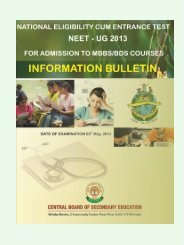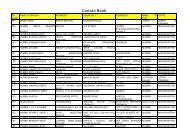Examination Syllabus - NEET-UG, 2013
Examination Syllabus - NEET-UG, 2013
Examination Syllabus - NEET-UG, 2013
You also want an ePaper? Increase the reach of your titles
YUMPU automatically turns print PDFs into web optimized ePapers that Google loves.
UNIT II: Current Electricity<br />
Electric current, flow of electric charges in a metallic conductor, drift velocity and mobility, and their relation with electric<br />
current; Ohm’s law, electrical resistance, V-I characteristics (liner and non-linear), electrical energy and power, electrical<br />
resistivity and conductivity.<br />
Carbon resistors, colour code for carbon resistors; series and parallel combinations of resistors; temperature dependence of<br />
resistance.<br />
Internal resistance of a cell, potential difference and emf of a cell, combination of cells in series and in parallel.<br />
Kirchhoff’s laws and simple applications. Wheatstone bridge, metre bridge.<br />
Potentiometer-principle and applications to measure potential difference, and for comparing emf of two cells;<br />
measurement of internal resistance of a cell.<br />
UNIT III: Magnetic Effects of Current and Magnetism<br />
Concept of magnetic field, Oersted’s experiment. Biot-Savart law and its application to current carrying circular loop.<br />
Ampere’s law and its applications to infinitely long straight wire, straight and toroidal solenoids. Force on a moving charge<br />
in uniform magnetic and electric fields. Cyclotron.<br />
Force on a current-carrying conductor in a uniform magnetic field. Force between two parallel current-carrying conductorsdefinition<br />
of ampere. Torque experienced by a current loop in a magnetic field; moving coil galvanometer-its current<br />
sensitivity and conversion to ammeter and voltmeter.<br />
Current loop as a magnetic dipole and its magnetic dipole moment. Magnetic dipole moment of a revolving electron.<br />
Magnetic field intensity due to a magnetic dipole (bar magnet) along its axis and perpendicular to its axis. Torque on a<br />
magnetic dipole (bar magnet) in a uniform magnetic field; bar magnet as an equivalent solenoid, magnetic field lines;<br />
Earth’s magnetic field and magnetic elements.<br />
Para-, dia-and ferro-magnetic substances, with examples.<br />
Electromagnetic and factors affecting their strengths. Permanent magnets.<br />
UNIT IV: Electromagnetic Induction and Alternating Currents<br />
Electromagnetic induction; Faraday’s law, induced emf and current; Lenz’s Law, Eddy currents. Self and mutual inductance.<br />
Alternating currents, peak and rms value of alternating current/ voltage; reactance and impedance; LC oscillations<br />
(qualitative treatment only), LCR series circuit, resonance; power in AC circuits, wattles current.<br />
AC generator and transformer.<br />
UNIT V: Electromagnetic Waves<br />
Need for displacement current.<br />
Electromagnetic waves and their characteristics (qualitative ideas only). Transverse nature of electromagnetic waves.<br />
Electromagnetic spectrum (radio waves, microwaves, infrared, visible, ultraviolet, x-rays, gamma rays) including elementary<br />
facts about their uses.<br />
UNIT VI: Optics<br />
Reflection of light, spherical mirrors, mirror formula. Refraction of light, total internal reflection and its applications optical<br />
fibres, refraction at spherical surfaces, lenses, thin lens formula, lens-maker’s formula. Magnification, power of a lens,<br />
combination of thin lenses in contact combination of a lens and a mirror. Refraction and dispersion of light through a prism.<br />
Scattering of light- blue colour of the sky and reddish appearance of the sun at sunrise and sunset.<br />
Optical instruments: Human eye, image formation and accommodation, correction of eye defects (myopia and<br />
hypermetropia) using lenses.<br />
Microscopes and astronomical telescopes (reflecting and refracting) and their magnifying powers.<br />
Wave optics: Wavefront and Huygens’ principle, reflection and refraction of plane wave at a plane surface using wavefronts.<br />
Proof of laws of reflection and refraction using Huygens’ principle.





